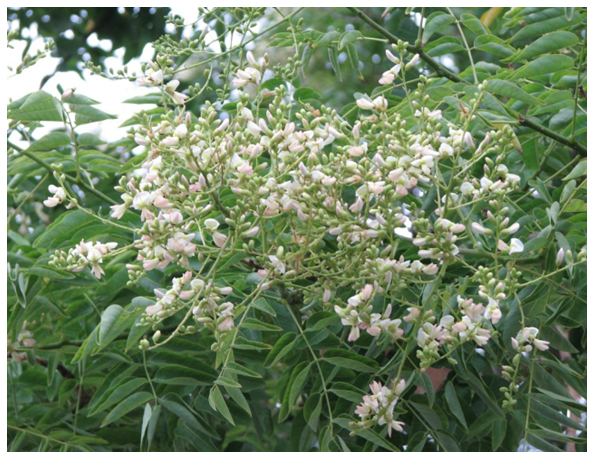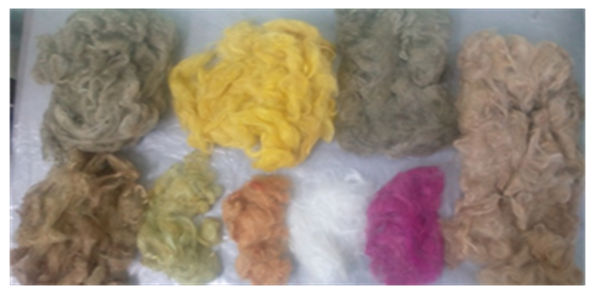-
Paper Information
- Paper Submission
-
Journal Information
- About This Journal
- Editorial Board
- Current Issue
- Archive
- Author Guidelines
- Contact Us
International Journal of Materials and Chemistry
p-ISSN: 2166-5346 e-ISSN: 2166-5354
2024; 14(1): 1-2
doi:10.5923/j.ijmc.20241401.01
Received: Dec. 20, 2023; Accepted: Jan. 10, 2024; Published: Jan. 12, 2024

Extraction of Natural Paint from Japanese Sofara Plant Dying Wool and Fabrics
Ibragim Askarov1, Shavkat Abdullaev2, Eldorbek Khaydarov3, Murodullokhon Mekhmonkhonov3
1DSc., Professor, Department of Chemistry, Andijan State University, Andijan, Uzbekistan
2DSc., Professor, Namangan State University, Namangan, Uzbekistan
3Namangan State University, Namangan, Uzbekistan
Correspondence to: Ibragim Askarov, DSc., Professor, Department of Chemistry, Andijan State University, Andijan, Uzbekistan.
| Email: |  |
Copyright © 2024 The Author(s). Published by Scientific & Academic Publishing.
This work is licensed under the Creative Commons Attribution International License (CC BY).
http://creativecommons.org/licenses/by/4.0/

The issue of dying blue is an important issue in the textile industry. Fabrics based on artificial dyes can cause skin allergies or skin diseases. The medicinal product is made on the basis of Sophora japonica (Safora), which contains rutin, flavonoids and other biologically active substances.
Keywords: Wool, Wash comb, Felt, Shaft, Soap, Comb, Rutin
Cite this paper: Ibragim Askarov, Shavkat Abdullaev, Eldorbek Khaydarov, Murodullokhon Mekhmonkhonov, Extraction of Natural Paint from Japanese Sofara Plant Dying Wool and Fabrics, International Journal of Materials and Chemistry, Vol. 14 No. 1, 2024, pp. 1-2. doi: 10.5923/j.ijmc.20241401.01.
1. Introduction
- Department of Chemistry of Natural Compounds of Tashkent State University opened in 1946 under the leadership of Academician O.S. Sadikova became a blacksmith of organic chemists specializing in the study of natural compounds. If we consider the chemical structure, mechanism of action and various transformations of alkaloids as the main direction of scientific research of the department and the problem laboratory opened in 1954, then research in the chemistry of natural plant dyes is no less important.When searching for alkaloid plants, plants were also found in which natural dyes accumulated. Natural dyes are complex organic compounds that color various animal and plant cells and tissues. Until the 2nd half of the 19th century. Many natural dyes were used to dye textiles, leather, paper, perfumes, food products, etc. Most of them play an essential role in the life of the organisms that produce them. Many natural dyes have significant physiological and antibiotic activity and are often used as therapeutic agents. They are also used in the perfumery industry, in studies by optical and electron microscopy in cytology and analytical chemistry. Natural dyes are widespread and chemically extremely diverse, mainly compounds of yellow, brown, black and red colors of different shades, very few blue and purple, green, as a rule, are absent. In the studies of Academicians O.S. Sadikov, G.V. Lazurevsky, natural dyes "Sophoreols" were isolated from various plant species of Sophora. Further, chalcone ammotamnidine and a number of flavonoid substances also having coloring properties were isolated from the plant Ammothamnus Lehmanni. From Sоphora yaponiсa dyes were isolated that dyed wool and other fabrics in a beautiful yellow color. In general, these works gave impetus to research in the field of flavonoid compounds. The main target was the Scutellaria plant. The genus Scutellaria is a very diverse plant species in the world flora and is represented by 360 species. 56 species grow in Central Asia, 32 species grow on the territory of Uzbekistan, which are used in folk medicine for the treatment of epilepsy, allergies, neurosis, hypertension and other diseases.
2. Materials and Methods
- The main flavonoids of plants of this genus - bacilli, baicalein, wogonin have antitumor, anti-HIV, antibacterial, anti-inflammatory and anticonvulsant effects. We have studied the chemical components of skullcap growing in the Fergana Valley for the content of flavonoids, phenol carboxylic acids, tannins, macro and microelements. An electronic presentation on the composition of phenolic substances in plants of the Scutellaria genus has been compiled. As a result of the studies carried out, the chemical properties and spectral characteristics were established - nepetoside A, immaculoside and wogonin-7-O-β-D-glucopyranoside turned out to be new natural compounds, and their chemical structure was established. Based on the complex use of chemical and spectral methods, 25 known flavonoids have been identified, including 10 flavone derivatives, 12 flavone glycosides, 2 flavones and 1 flavonol. To study the crystal structures of wogonin, an X-ray diffraction study was carried out.Results of pharmacological studies of flavonoids apigenin, cinaroside, wogonin-7-O-β-D-glucopyranoside, nepetoside A, (±) -5,2`-dihydroxy-6,7,8,6`-tetramethoxyflavanone and chrysin-7-O -β-D-glucuronide made it possible to identify among them substances with pronounced anti-inflammatory and gastroprotective properties.As an additional source of cynaroside – flavonoid hypoazotemic action suggested aboveground part of Scutellaria nepetoides M. Pop. Taking into account that even in ancient settlements, natural plant dyes were widely used for dyeing fabrics, food products, we carried out research to find dyes for dyeing wool of sheep and rams. The basis was taken from the goods obtained from coarse wool in the form of kigiz, carpets, various household utensils. In Europe, in recent years, wool products have been widely developed in the form of bags, jewelry, various underwear as souvenirs.
3. Result and Discussion
- Due to the fact that these products are bright and beautiful, it is required to use for their coloring are not harmful natural dyes. These include the bark pomegranate, barberry bark, grave, walnut pericarp and others. Taking into account the research of Uzbek scientists, restored technology for dyeing woolen products with flowers and fruits ornamental cultivated plant Sofora Yaponica. Dyeing was carried out in presence of mordants of potassium alum, copper sulfate, sulfate iron, tin chloride, chromium salts. The dyed wool is shown below in the pictures (Figure 1 and Figure 2).
 | Figure 1. The dyed wool of Sofora Yaponica |
 | Figure 2. The dyed wool of Sofora Yaponica |
 | Figure 3. Dyed wool |
 Abstract
Abstract Reference
Reference Full-Text PDF
Full-Text PDF Full-text HTML
Full-text HTML